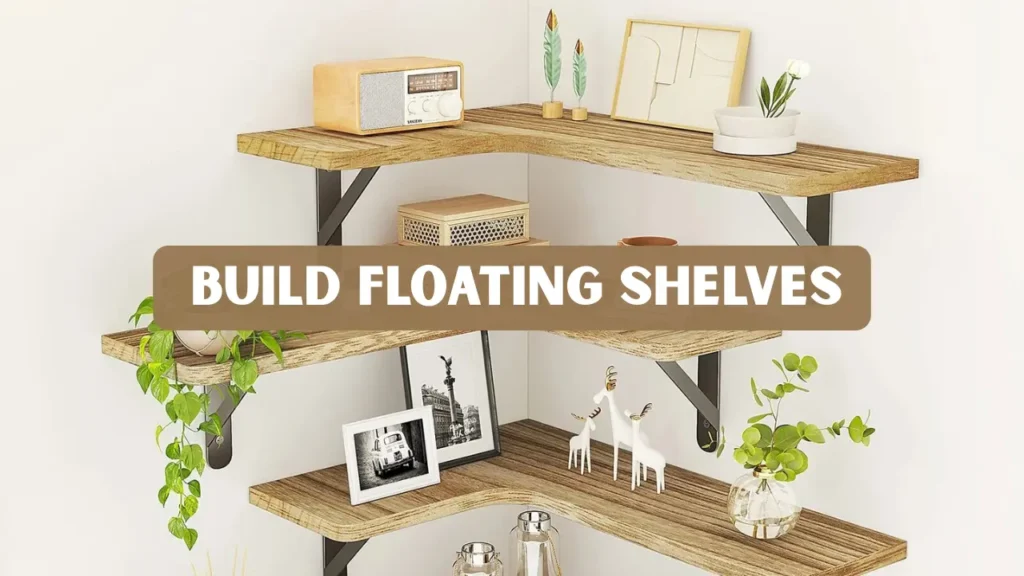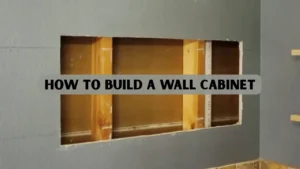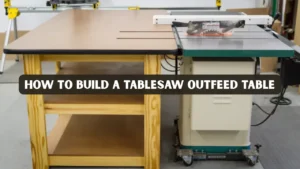Key Takeaways
- When you build floating shelves, you enhance storage & visual appeal without bulky supports.
- You’ll need basic tools like a drill, saw, and level.
- Careful planning ensures balanced placement and long-lasting results
- The process includes measuring, cutting, assembling, and mounting.
- Suitable for any room: living room, kitchen, bedroom, or home office.
Why Build Floating Shelves for Your Home
Learning to build floating shelves is one of the most rewarding home projects. They help utilize vertical wall space, making your home look neat and stylish. Unlike traditional shelves, floating shelves are mounted without visible brackets, giving a clean and minimal look that complements any design theme.
You can personalize them to match your décor, paint them to blend with your walls or stain them to highlight the natural wood grain. They are also ideal for small spaces where floor area is limited, offering functionality without clutter.
Tools and Materials You’ll Need
Before you start, gather all the tools and materials. Preparation saves time and helps you maintain accuracy throughout the project.
Tools:
- Measuring tape
- Power drill with bits
- Circular or miter saw
- Stud finder
- Screwdriver
- Level
- Sandpaper or sander
Materials:
- Wood boards (pine, oak, birch, or plywood)
- Wood screws and wall anchor
- Wood glue
- Wood filler
- Stain or paint
- Polyurethane sealant (optional for moisture resistance)
- Mounting cleats or hidden brackets
Having everything ready ensures a smooth process when you begin to build floating shelves.
Planning Your Floating Shelf Project
Every great DIY project starts with a plan. Begin by selecting the wall where you want to install your shelves. Consider both aesthetics and practicality. For instance, floating shelves above a couch, in a kitchen corner, or beside a bed can serve both decorative and functional purposes.
When planning:
- Height: Maintain 12–16 inches of space between shelves.
- Depth: Standard shelves range between 8 and 10 inches deep.
- Length: Keep it proportionate to your wall width.
- Wall Type: Use a stud finder to locate secure mounting points.
Good planning ensures your shelves are symmetrical, safe, and visually appealing.
Step by Step Guide
This hands-on guide covers every stage of the process, from cutting the boards to decorating the final product.
Step 1: Measure and Mark Your Wall
Use a pencil to mark where each shelf will go. Check for level alignment to prevent crooked installations. If possible, use painter’s tape to visualize the shelf’s final position before drilling.
Tip: Align the shelves with existing furniture for a balanced look.
Step 2: Cut Your Wood Boards
Cut your boards according to your desired shelf length using a circular or miter saw. Each shelf typically consists of a top board, bottom board, and two side pieces.
Sand the edges until smooth to avoid splinters and ensure a professional finish. Consistency in dimensions across multiple shelves makes installation easier and more attractive.
Step 3: Build the Frame (Support Cleat)
The internal frame or cleat supports the entire shelf.
- Cut one long piece for the back and shorter pieces for cross-supports.
- Screw the cross-supports into the back piece to create a sturdy rectangular frame.
- Use wood glue at each joint for added strength.
This internal frame will later be mounted directly to the wall studs.
Step 4: Assemble the Shelf
With the frame ready, attach the top, bottom, and side panels.
- Apply wood glue along the edges.
- Secure with screws to ensure a tight fit.
- Check for square corners with a carpenter’s square.
Once assembled, sand the exterior until smooth, and fill any visible holes with wood filler for a flawless appearance.
Step 5: Apply Stain or Paint
Choose a finish that complements your home décor.
- For a natural look, use a wood stain to enhance the grain.
- For a modern look, paint the shelves in matte or gloss finishes.
- Apply polyurethane if you’re installing shelves in humid spaces like bathrooms or kitchens.
Allow each coat to dry completely before applying the next.
Step 6: Mount the Support Frame
This step determines how strong your shelves will be.
- Locate the wall studs with a stud finder.
- Align the cleat on the wall and drill pilot holes.
- Screw the cleat securely into the studs using long wood screws.
- Double-check that it’s perfectly level before tightening all screws.
The sturdier your base, the longer your shelves will last.
Step 7: Slide the Shelf Onto the Frame
Carefully slide your assembled shelf over the wall-mounted frame. It should fit snugly. For added security, apply a small amount of wood glue along the top edge of the cleat before sliding the shelf in place.
Once installed, the shelf should appear to “float,” with no visible supports.
Step 8: Style and Decorate
Now comes the fun part. Decorate your new shelves with plants, books, candles, or collectibles. Balance heavy items toward the ends and lighter pieces toward the center for a visually appealing display.
Choosing the Right Wood for Floating Shelves
Selecting the right type of wood ensures durability and aesthetic appeal.
Best wood options include:
- Pine: Budget-friendly, lightweight, and easy to work with.
- Oak: Durable and elegant with a pronounced grain.
- Birch: Smooth texture, great for painting.
- Walnut: Rich tone and premium finish for luxury interiors.
Consider the color and texture that suit your existing décor before you build floating shelves.
Finishing Touches for a Professional Look
Details make a big difference in the final outcome.
Pro tips:
- Pre-drill holes to prevent splitting.
- Hide screw heads with filler for a clean surface.
- Sand between coats of paint or stain for an even finish.
- Apply a clear sealant for long-lasting protection.
These steps ensure your shelves look store-bought even though they’re handmade.
Maintenance and Care
Floating shelves are low-maintenance, but regular care keeps them looking new.
- Dust weekly with a soft microfiber cloth.
- Avoid overloading; distribute weight evenly.
- Wipe up spills quickly to prevent warping.
- Reapply finishes every few years for a fresh look.
With proper maintenance, your floating shelves can last decades.
Common Mistakes to Avoid
Avoid these common pitfalls to ensure success:
- Failing to locate wall studs before mounting.
- Using cheap wood that bends under weight.
- Rushing through drying or sanding.
- Forgetting to check alignment at each step.
Taking your time leads to cleaner, safer, and longer-lasting results.
Real-World Example: Small Room Transformation
A homeowner recently transformed a narrow hallway into a stylish display area using three pine floating shelves. After staining them dark walnut and mounting them above a bench, the space became both functional and elegant. The shelves now hold baskets, books, and art, showcasing how such a simple DIY project can dramatically change a home’s atmosphere.
This example highlights that even small areas can benefit from creativity and careful craftsmanship.
Expert Tips for DIY Success
Professional carpenters recommend these time-tested techniques:
- Measure twice, cut once.
- Always double-check level alignment.
- Use high-quality screws and anchors.
- Avoid over-tightening screws to prevent cracks.
- Plan your layout before cutting wood.
Applying these insights ensures every step of your project is solid and successful.
Creative Floating Shelf Design Ideas
Looking for inspiration beyond the basics? Try these creative options:
- Corner shelves: Ideal for maximizing unused corners.
- Ladder-style shelves: Combine multiple floating tiers for dramatic height.
- Rustic designs: Use reclaimed wood for character and warmth.
- Geometric layouts: Arrange shelves in asymmetrical patterns for a bold, modern statement.
With creativity, you can design shelves that are as unique as your space.
Conclusion
When you build floating shelves, you combine functionality with creativity. These shelves not only provide valuable storage but also elevate the look of your room. From selecting the right materials to securing the last screw, every step brings satisfaction and pride.
Whether you’re updating a living room, organizing a kitchen, or decorating a hallway, this DIY project offers endless possibilities. With patience and precision, you’ll end up with beautiful, long-lasting shelves that reflect your personal style.
FAQs
How much weight can floating shelves hold?
Well-constructed shelves attached to wall studs can hold between 30–50 pounds per stud, depending on materials and mounting hardware.
Can I install floating shelves on plaster or concrete walls?
Yes. Use masonry anchors or toggle bolts designed for your wall type to ensure secure installation.
What kind of finish should I use in the kitchen?
A clear polyurethane or water-resistant varnish works best for areas exposed to humidity and grease.
Should I use wood glue in addition to screws?
Absolutely. Wood glue reinforces joints and prevents long-term loosening.
Are floating shelves suitable for heavy objects like books?
If mounted on studs and properly supported, they can safely handle heavy décor and books.




